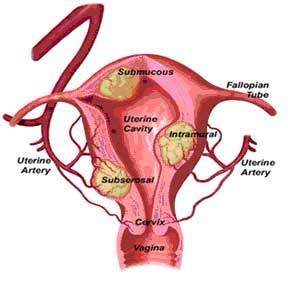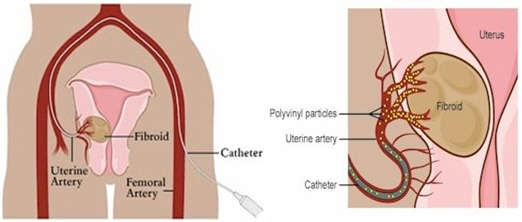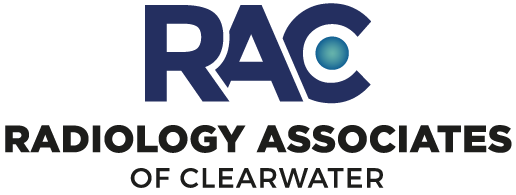Uterine Artery Embolization
Minimally Invasive Treatment of Uterine Fibroids
Uterine Fibroids are a very common benign (non-cancerous) tumor in women, occurring in approximately 25-40% of American women overall, but in as many as 50% of African-American women. They are the most common tumors of the female genital tract. There are many names for this condition including uterine fibroid tumors, uterine fibroids, fibroid uterii, uterine leiomyomas (leiomyomata). These tumors are not related to other fibroid growths in the body (no relationship to fibroid tumors in the breast).

Majority of women have no symptoms or problems with this condition and require no treatment. However, depending on size, location and number of fibroids, they may cause:
- Heavy, prolonged menstrual periods and unusual monthly bleeding, sometimes with clots. This can lead to anemia.
- Pelvic pain and pressure
- Pain in the back and legs
- Pain during sexual intercourse
- Bladder pressure leading to a frequent urge to urinate
- Pressure on the bowel, leading to constipation and bloating
- Abnormally enlarged abdomen
Uterine fibroids are the most frequent indication for hysterectomy in premenopausal women and, therefore, are a major public health issue. Of the 600,000 hysterectomies performed annually in the United States, one-third are due to fibroids.
Best imaging modality for evaluation of fibroids is an MRI. Magnetic resonance imaging (MRI) improves the patient selection for who should receive nonsurgical uterine fibroid embolization (UFE) to kill their tumors. Interventional radiologists can use MRIs to determine if a tumor can be embolized, detect alternate causes for the symptoms, identify pathology that could prevent a women from having UFE and avoid ineffective treatments. Using an MRI rather than ultrasound is like listening to a digital CD rather than a record – the quality is better in every way. By working with a patient’s gynecologist, interventional radiologists can use MRIs to enhance the level of patient care through better diagnosis, better education, better treatment options and better outcomes.
Uterine Fibroid Embolization (UFE)
Non-surgical Uterine Fibroid Embolization is a major advance in women’s health. Uterine fibroid embolization (UFE), also known as uterine artery embolization, is performed by an interventional radiologist who is trained to perform this and other types of embolization and minimally invasive procedures. It is performed while the patient is conscious, but sedated and feeling no pain. It does not require general anesthesia.
The interventional radiologist makes a tiny nick in the skin in the groin and inserts a catheter into the femoral artery. Using real-time imaging, the physician guides the catheter through the artery and then releases tiny particles, the size of grains of sand, into the uterine arteries that supply blood to the fibroid tumor. This blocks the blood flow to the fibroid tumor and causes it to shrink and die.

UFE Recovery Time
Fibroid embolization usually requires a hospital stay of one night. Pain-killing medications and drugs that control swelling typically are prescribed following the procedure to treat cramping and pain. Many women resume light activities in a few days and the majority of women are able to return to normal activities within seven to 10 days.
UFE Efficacy
- On average, 85-90 percent of women who have had the procedure experience significant or total relief of heavy bleeding, pain and/or bulk-related symptoms.
- The procedure is effective for multiple fibroids and large fibroids.
- Recurrence of treated fibroids is very rare. Short and mid-term data show UFE to be very effective with a very low rate of recurrence. Long-term (10-year) data are not yet available, but in one study in which patients were followed for six years, no fibroid that had been embolized regrew.
Uterine Fibroid Embolization is not appropriate for all patients with symptomatic fibroids. The biggest issue involves the treatment of women wishing to have this procedure for treatment of infertility, for which other treatments should be considered first. However, the majority of women with symptomatic fibroids who do not want to undergo hysterectomy are suitable for this UFE. If you have uterine fibroids that are thought to be causing symptoms, discuss this condition with your gynecologist.
- Home
- About Us
- Physicians
- Technology
-
Services
- General Radiology
-
Interventional Radiology
- Angiography
- Chemoembolization
- Radiofrequency Ablation
- Uterine Artery Embolization
- Vericose Vein Treatment
- Arthrography
- Discography
- Epidural Steroid Injections
- Epidurography
- Facet Joint Injections
- Kyphoplasty
- MRI Arthrography
- Nerve Root Blocks
- Radiofrequency Rhizotomy
- Sacroiliac Joint Injection
- Trigger Point Injections
- Stellate Ganglion Block
- Vertebroplasty
- Facet Nerve Injection
- Myelogram
- Neuroradiology
- Women's Imaging and Interventions
- Orthopedic and Sports Imaging
- Oncological Diagnostics and Interventions
- Cardiovascular Radiology
- Locations
- Contact









